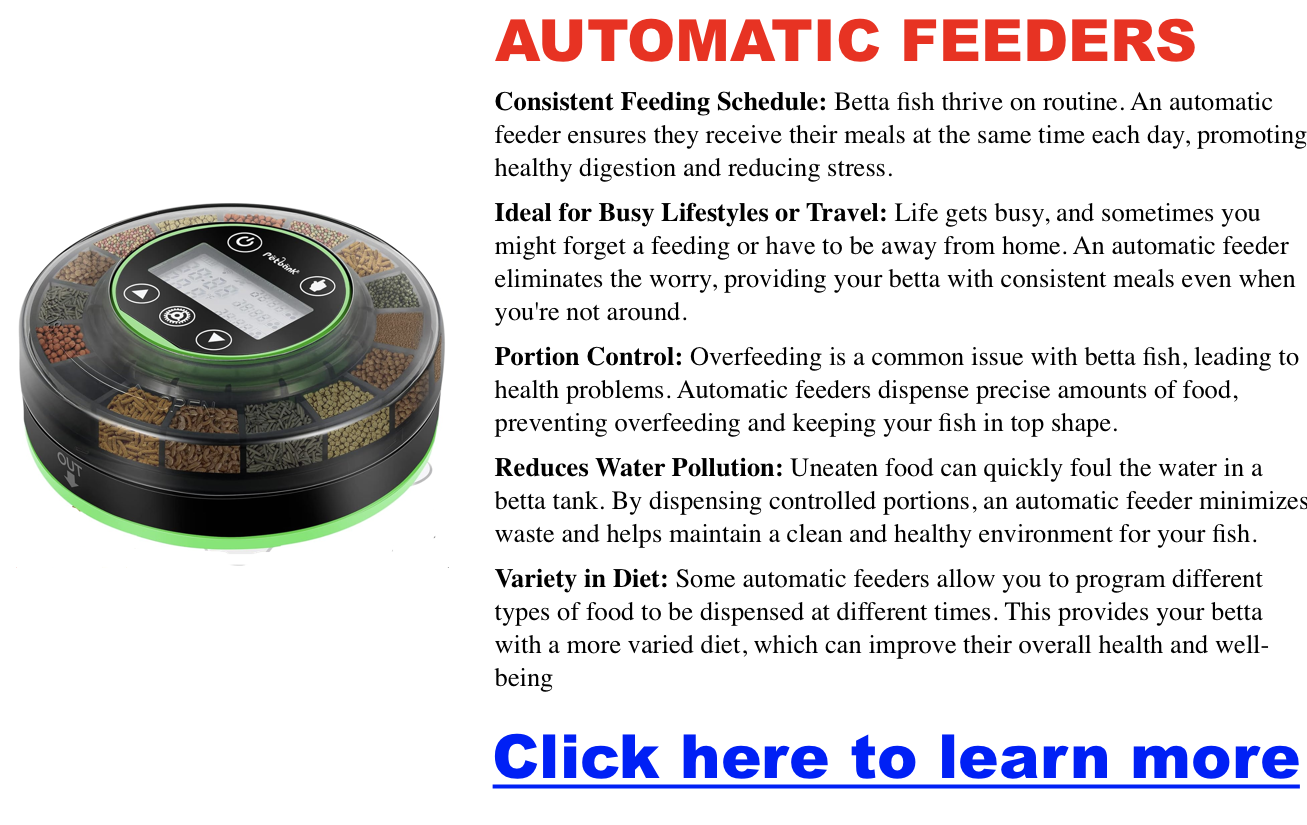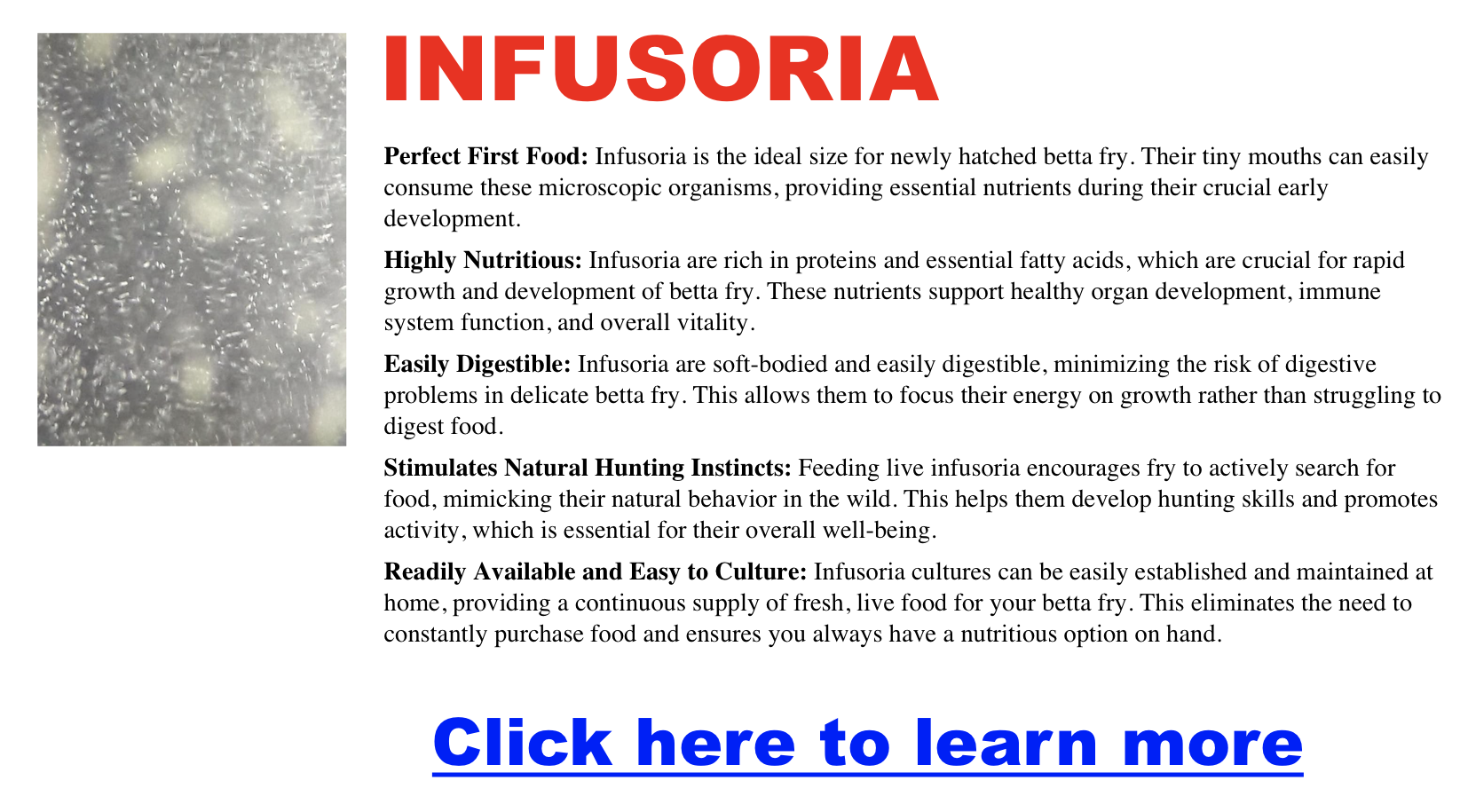Matt
Can Betta Fish Eat Goldfish Food
Picture this: you’re a new betta fish owner, excited to care for your vibrant finned friend. You’ve stocked up on all the essentials, but suddenly realize you’re out of betta food. Glancing at your fish supplies, you spot a container of goldfish food. Can you use it in a pinch?
The short answer is yes, bettas can technically eat goldfish food. However, it’s not an ideal long-term solution and can lead to health problems.
Let’s dive into the reasons why and explore better options to keep your betta happy and thriving.
Understanding Betta and Goldfish Dietary Needs
Bettas and goldfish might both be popular aquarium fish, but their dietary needs differ significantly due to their evolutionary history and natural habitats.
- Bettas: The Carnivorous Hunters: In the wild, bettas primarily feed on insects and larvae, making them obligate carnivores. Their digestive system, with its short intestinal tract, is adapted for processing meat-based foods. A diet rich in protein is crucial for their energy, growth, and overall health.
- Goldfish: The Omnivorous Grazers: Goldfish, on the other hand, are omnivores, consuming both plant and animal matter. Their digestive system is more versatile, allowing them to process a wider variety of foods. Their commercial diets reflect this, typically containing a mix of protein sources and plant matter.
The Nutritional Divide: Betta Food vs. Goldfish Food
The difference in dietary needs between these two species translates directly into their food. Here’s a breakdown of the nutritional differences between goldfish food and betta food:
- Protein Power: Betta food typically boasts a protein content of around 40-45%, essential for their carnivorous lifestyle. Goldfish food, with its lower protein content (around 25-30%), falls short of meeting a betta’s needs. Insufficient protein can cause stunted growth, weakened immune system, and other health problems.
- Carbohydrate Caution: Goldfish food often contains higher levels of carbohydrates to support their plant-based dietary needs. Bettas, however, don’t require as many carbohydrates. Excess carbs can be difficult for them to digest, potentially leading to constipation, bloating, or even swim bladder issues.
- Other Nutritional Factors: While both betta and goldfish food contain fats, vitamins, and minerals, the specific types and amounts can vary to cater to each species’ unique requirements. Additionally, some goldfish foods contain artificial color enhancers that may be harmful to bettas.
The Risks of a Goldfish Food Diet for Bettas
Feeding your betta goldfish food regularly can lead to health problems like:
- Digestive Issues: The high carbohydrate content and plant matter in goldfish food can strain your betta’s digestive system, leading to constipation, bloating, or other complications.
- Nutritional Deficiencies: A lack of sufficient protein can hinder your betta’s growth, immune function, and overall vitality.
- Potential Harm from Additives: Artificial color enhancers found in some goldfish foods can be detrimental to bettas.
While a few occasional bites of goldfish food might not cause immediate harm, it’s crucial to avoid making it a staple in your betta’s diet.
The Right Food for Your Betta: Better Alternatives
To keep your betta healthy and thriving, it’s important to provide them with a diet that meets their specific nutritional needs.
- High-Quality Betta Food: Invest in reputable brands of betta pellets or flakes. Check the ingredients list to ensure a high protein content from sources like fish meal, shrimp meal, or insects.
- Treats and Variety: Offer your betta occasional treats of frozen, freeze-dried or live foods like brine shrimp or bloodworms. These provide additional protein and enrichment.
What Fish Can Live With Bettas
The betta fish, with its vibrant colors and flowing fins, is a captivating addition to any aquarium. However, their reputation for aggression often leads to the misconception that they must live alone. The truth is, with careful planning and the right tankmates, you can create a thriving community tank where your betta reigns supreme.
Understanding Betta Temperament
Bettas are territorial by nature and can be particularly aggressive toward other males or fish with long, flowing fins that they might mistake for rivals. While female bettas can sometimes be kept together in groups known as “sororities,” it requires a carefully managed setup and is not recommended for beginners.
Choosing the Right Betta Tankmates: Common Options
| Compatible Fish | Betta Variations |
|---|---|
| Snails | Female, Plakat, Dumbo Ear |
| Shrimp | Female, Plakat, Dumbo Ear |
| Corydoras Catfish | Female, Plakat, Dumbo Ear |
| Harlequin Rasboras | Female, Plakat, Dumbo Ear |
| Neon or Ember Tetras | Female, Plakat, Dumbo Ear |
| Otocinclus Catfish | Female, Plakat, Dumbo Ear |
| Kuhli Loaches | Female, Plakat, Dumbo Ear |
| Dwarf Gouramis | Female (with caution) |
| White Cloud Mountain Minnows | Female, Plakat, Dumbo Ear |
| Zebra Danios | Female, Plakat, Dumbo Ear |
When selecting tankmates for your betta, it’s essential to prioritize peaceful species that won’t trigger their aggression. Some popular choices include:
- Snails: These gentle creatures help keep the tank clean by eating algae and leftover food. Mystery snails and nerite snails are excellent options.
- Shrimp: Like snails, shrimp contribute to a clean environment and are generally peaceful. Ghost shrimp and Amano shrimp are good choices.
- Corydoras Catfish: These bottom-dwelling fish are peaceful and won’t compete with your betta for space.
- Harlequin Rasboras: These small, schooling fish add life and movement to the tank without provoking your betta.
- Neon or Ember Tetras: These colorful fish bring vibrancy to the aquarium. Keep them in a school of at least six to ensure their well-being.
Lesser-Known but Compatible Tankmates
For those seeking a more unique community tank, consider these less common but still suitable tankmates:
- Otocinclus Catfish: These tiny algae eaters are peaceful and stay mainly on the bottom of the tank, minding their own business.
- Kuhli Loaches: These eel-like fish are nocturnal and prefer to hide during the day, minimizing interactions with your betta. Provide plenty of caves and hiding spots for them.
- Dwarf Gouramis: While some gouramis can be aggressive, dwarf gouramis are generally peaceful and can coexist with bettas in larger tanks (20+ gallons). Monitor their behavior closely, especially at first.
- White Cloud Mountain Minnows: These hardy and peaceful fish add movement to the upper levels of the tank.
- Zebra Danios: These active fish can coexist with bettas in larger tanks. Their constant movement may even entertain your betta.
Choosing the Right Betta
Some betta varieties are naturally more peaceful and compatible with other fish. Female bettas, Plakat bettas (with shorter fins), and Dumbo Ear bettas are generally calmer options. When selecting your betta, observe its behavior at the pet store. Avoid fish that display aggression towards other fish or their reflection in the glass.
Setting Up for Success
- Tank Size: A larger tank (at least 10 gallons, larger for communities) provides more space for everyone and reduces the chances of aggression.
- Research: Thoroughly research the specific needs of each tankmate before adding them.
- Backup Plan: Have a separate tank or a divider ready in case aggression occurs.
- Observation: Closely monitor your betta’s behavior after introducing new tankmates.
How Often to Feed Betta Fish
Betta fish, known for their vibrant personalities and stunning fins, can be picky eaters. If you’re asking, “How often should I feed my betta fish?” or “How much should I feed my betta fish?”—you’ve come to the right place! In this guide, we’ll dive into the details of betta feeding, helping you tailor a feeding plan that keeps your Betta happy, healthy, and thriving.
Personalizing Your Betta’s Feeding Schedule
How Often to Feed a Betta Fish
The Golden Rule: 1-2 Times a Day
Every Betta is different, with unique behaviors, tank setups, and dietary needs. While a general rule of thumb is to feed your Betta 1-2 times a day, the exact amount and frequency should be based on your individual Betta’s traits, such as its activity level, size, and personality
Most bettas thrive when fed once or twice a day. However, this is just a starting point. If your Betta is more active, they might require slightly more food to support their metabolism. On the other hand, less active bettas may do fine with just one feeding per day.
A consistent feeding schedule helps your Betta maintain a healthy weight and avoid digestive issues like bloating. Here’s a practical tip: fast your Betta for one day a week to help with digestion and prevent overfeeding.
Why Proper Feeding Matters
Feeding your Betta the right amount of food at the right frequency. Overfeeding can lead to obesity, swim bladder disease, and other health problems, while underfeeding can result in malnutrition and lethargy. A balanced diet ensures your Betta thrives, showcasing vibrant colors, active behavior, and a long, healthy life.
Understanding Your Betta’s Dietary Needs
- Carnivores at Heart: Bettas are natural carnivores, feasting on insects and small crustaceans in the wild. In your aquarium, they need a diet rich in protein.
- Essential Nutrients: Look for food that provides a balance of protein, fats, vitamins, and minerals to support their overall health.
- Signs of a Healthy Diet: A well-fed betta will display bright colors, an eagerness to eat, and energetic swimming.
How Much to Feed: Mastering Portion Control
Betta fish are notorious for their seemingly endless appetites. They’ll happily gobble up anything you drop in the tank, leading to a common misconception that their stomachs are as big as their eyes. However, overfeeding is a serious issue that can cause health problems.
The “Two-Minute Rule”
A good starting point for portion control is the “two-minute rule”: Feed your Betta only what they can consume within two minutes. This helps prevent overeating and keeps the water clean. However, remember that this is just a guideline. Observe your Betta’s behavior during feeding to ensure they’re getting enough without overindulging.
Visual Cues: Is My Betta Full?
- Slightly Rounded Belly: A betta with a full stomach will have a slightly rounded belly, but not bloated.
- Loss of Interest: If your Betta stops eating or swims away from the food, it’s likely full.
- Leftover Food: Any food remaining after a few minutes indicates you’ve fed too much. Remove it promptly to avoid water quality issues.
Common Mistakes to Avoid
- Assuming a Bigger Belly Means a Happy Fish: A distended belly is a sign of overfeeding, not contentment.
- Feeding Based on Package Instructions: Food manufacturers often recommend larger portions than necessary. Start with smaller amounts and adjust based on your Betta’s individual needs.
- Ignoring Uneaten Food: Leaving uneaten food in the tank can lead to ammonia spikes and harm your Betta’s health.
Factors Affecting Feeding Frequency and Amount
Several factors influence how much and how often you should feed your Betta:
- Activity Level: A more active betta will naturally burn more calories and require more food.
- Size & Age: Larger and younger bettas generally need more food than smaller or older ones.
- Water Temperature: Warmer water temperatures can increase metabolism, leading to a greater need for food.
- Type of Food: Pellets are denser than flakes, and live or frozen foods may require different portioning.
Choosing the Best Betta Food
- High-Quality Pellets: These should form the foundation of your Betta’s diet, providing essential nutrients. Choose pellets specifically formulated for bettas.
- Live & Frozen Foods: Supplement with options like brine shrimp, bloodworms, and daphnia to add variety and enrichment.
- Treats: Occasionally offer treats like freeze-dried foods or small pieces of blanched vegetables.
Establishing a Feeding Routine
- The “Two-Minute Rule“ and Beyond: Start by feeding your Betta what they can consume within 2 minutes. Observe their behavior and adjust the amount accordingly.
- Fasting Days: Incorporate a fasting day once a week to aid digestion and prevent overfeeding.
- Feeding Times: Feed your Betta consistently each day to help them establish a routine.
Troubleshooting Common Issues
- Betta Not Eating: This could be due to illness, stress, poor water quality, or simply disliking the food. Investigate the cause and make necessary adjustments.
- Overfeeding: Signs include a bloated belly, lethargy, and constipation. Reduce feeding amounts and frequency if you observe these symptoms.
- Constipation: If your Betta is constipated, try offering them a small piece of cooked pea or daphnia to help with digestion.
Special Feeding Scenarios
- Feeding Betta Fry: Baby bettas need specialized food like infusoria or baby brine shrimp and require more frequent feedings.
- Vacation Feeding: If you’re going away, use an automatic feeder or pre-portioned food blocks. Avoid overfeeding before leaving, as this can negatively impact water quality.
Conclusion
Feeding your betta fish properly is key to their well-being. Remember, each Betta is an individual, so observe their behavior and adjust their feeding plan accordingly. Providing a balanced diet and following these guidelines’ll ensure your Betta lives a long, healthy, and vibrant life.
How Long Can Betta Fish Go Without Food
In their natural habitat, betta fish may experience periods of food scarcity. They’ve evolved to withstand these lean times by storing energy reserves. This means they can technically survive for 7-14 days without eating. However, it’s important to understand that this is a survival mechanism, not an ideal situation.
The Hidden Cost of Fasting
While betta fish can survive for extended periods without food, it doesn’t mean they should. Prolonged fasting puts significant stress on their bodies and compromises their immune systems. After about 5 days, they may become lethargic, lose color, and be more susceptible to diseases.
Factors Affecting Fasting Duration
Several factors influence how long a betta fish can comfortably fast:
- Overall health: A healthy fish will have more energy reserves to draw upon.
- Age: Young fish may have a harder time fasting than adults.
- Water conditions: Poor water quality adds stress, making fasting more difficult.
- Feeding habits: A fish used to regular meals may struggle more with sudden fasting.
Spotting Signs of Starvation
It’s crucial to recognize the signs of starvation in your betta fish:
- Lethargy: Reduced activity and a lack of interest in food.
- Loss of color: Fading or dulling of their vibrant colors.
- Sunken belly: An indented abdomen indicates a lack of food intake.
- Fin clamping: Holding fins close to the body can be a sign of stress or illness.
Missed a Feeding? Don’t Panic!
If you accidentally miss one feeding, don’t worry too much. Your betta will likely be fine. Just resume their normal feeding schedule as soon as possible.
Planning for Extended Absences
If you’ll be away for more than a few days, you have a couple of options:
- Automatic feeders: These can dispense pre-measured amounts of food at set intervals. However, they can malfunction, so test them thoroughly beforehand.
- Fish sitters: Ask a friend or neighbor to feed your betta. Provide clear instructions on how much and what type of food to give.
Fasting as a Last Resort
Fasting should only be considered for short periods (up to 4-5 days) and only if absolutely necessary. It’s always best to prioritize regular feeding to keep your betta happy and healthy.
Caring for Betta Fish Fry
Witnessing the birth of betta fry is an exhilarating experience for any fish enthusiast. But as these tiny creatures emerge from their eggs, they embark on a delicate journey toward adulthood. Your role as their caretaker is crucial in ensuring their healthy development and survival. If your bettas are still eggs, we have a great article on the topic here.
In this guide, we’ll delve into the essential aspects of betta fry care, equipping you with the knowledge and confidence to raise thriving, vibrant fish.
Feeding Your Betta Fry: Tiny Appetites, Big Needs
- The First Few Days: Nature’s Provision – In their initial 2-3 days, betta fry rely on the nutrients stored in their egg sacs. During this time, there’s no need for external food.
- Early Stages: Microscopic Feasts – Once they become free-swimming, their tiny mouths crave microscopic delights. Infusoria, liquid fry food, and vinegar eels are excellent choices to kick-start their growth.
- After One Week: A Heartier Diet – As they grow, their appetites increase. Introduce baby brine shrimp (BBS) once daily, complemented by micro worms like Walter or banana worms. These protein-rich options fuel their rapid development.
- Feeding Frequency and Portion Control: The Goldilocks Principle – Aim for 2-3 small feedings daily. The key is to offer only what they can consume within 3-5 minutes. Overfeeding can impact water quality and cause health problems, so moderation is key.
Maintaining Pristine Water Quality: A Clean Slate for Growth
- Temperature: The Comfort Zone – Betta fry thrive in warm waters. Maintain a stable temperature between 82-85°F (28-29°C) to promote optimal growth and metabolism.
- Water Changes: The Fountain of Youth – Frequent water changes are vital for removing waste and maintaining pristine conditions. Daily small water changes or 25% twice-weekly changes are ideal. Make sure to dechlorinate water before adding it to the tank.
- pH Level: The Balancing Act – Aim for a slightly acidic pH of 6.6-6.8. This range helps reduce ammonia toxicity, ensuring a safe environment for your fry.
Setting Up the Ideal Fry Tank: A Cozy Haven
- Tank Size: Room to Grow – A 20-gallon tank or larger is recommended for grow-out, providing ample space for your fry to swim and explore as they mature.
- Filtration: The Gentle Current – Choose a gentle filter that maintains water quality without creating strong currents that could stress the fry.
- Bare-Bottom Tank: Simplicity and Hygiene – A bare-bottom tank is easiest to clean and prevents fry from getting trapped in substrate.
- Plants and Hiding Places: Security and Enrichment – Live plants not only add beauty but also provide natural hiding spots and a source of infusoria. You can also include artificial plants or caves to create a sense of security.
Additional Care Tips: Nurturing Beyond the Basics
- Monitor Growth: The Individual Touch – Fry grow at different rates. Observe them closely, ensuring everyone is thriving and adjusting their care as needed.
- Separate Aggressive Fry and Sexes: Peace and Harmony – As your fry mature, some may exhibit aggression. Separate any bullies to prevent injuries. Additionally, separate males and females as they develop to avoid early breeding and aggression.
- Avoid Overfeeding: The Bellyache Blues – Overfeeding, particularly with baby brine shrimp, can lead to swim bladder issues and other health problems. Remember, small, frequent meals are the way to go.
Caring for Baby Betta Fish
Welcoming a baby betta fish into your home is an exciting experience. These tiny, vibrant creatures bring joy and wonder to any space. However, raising baby bettas, or fry, requires special attention and care compared to their adult counterparts. If you have a younger betta, we have articles that talk about betta fish eggs, and betta fry care as well.
For now let’s explore the essential aspects of baby betta care to help you ensure your little swimmers thrive and grow into beautiful, healthy adults.
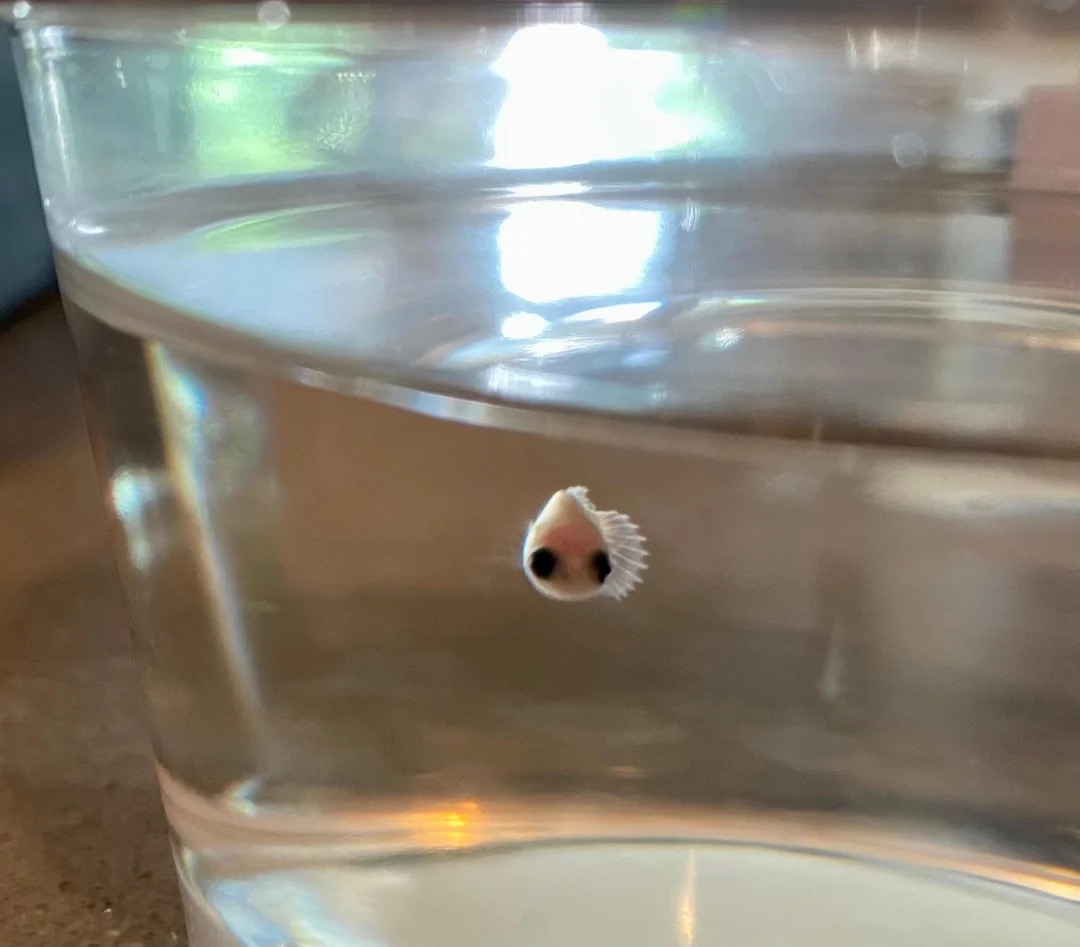
Click here to Buy Exotic Baby Betta Fish
Creating the Perfect Water World
Just like us, baby bettas are sensitive to their environment. Providing them with the right water conditions is crucial for their health and happiness.
- Temperature is Key: Imagine being in a room that’s too hot or too cold—uncomfortable, right? Baby bettas feel the same way about their water. Aim for a temperature between 76-84°F, with 80°F being ideal. Warmer water helps boost their metabolism and strengthens their immune system, reducing stress and the risk of diseases.
- Pristine Water Conditions: Baby bettas are more delicate than adults and require pristine water conditions. Think of it like a nursery for human babies—cleanliness is paramount! Frequent water changes are essential, especially if you have multiple babies in one tank, as they can stress each other and hinder growth. Use a gentle sponge filter to keep the water clean and clear to avoid harming them with strong currents.
Fueling Growth with the Right Diet
Just like human babies, baby bettas need plenty of nutritious food to grow big and strong.
- Frequent Feedings: Baby bettas have higher caloric needs than adults, so they must eat more often. Aim for 2-3 small daily feedings to support their rapid growth and development.
- A Varied and Nutritious Menu: A diverse diet ensures your baby betta gets all the necessary nutrients. Give a mix of live or frozen foods like bloodworms, brine shrimp, daphnia, and tubifex worms. These are packed with protein and essential nutrients. You can also supplement with small pellets (0.5 mm) for small fish. Brands like New Life Spectrum and Fluval Bug Bites are great options. Avoid larger pellets or flake foods, as these can be difficult to digest.
- Feeding Guidelines: A good rule of thumb is to feed your baby betta until you see a slight bulge in its belly. This indicates that it is adequately fed. If the bulge remains after feeding, consider reducing the amount of food in the next feeding.
Providing a Safe and Comfortable Home
Creating a cozy and secure environment is essential for your baby betta’s well-being.
- Tank Size Matters: While baby bettas are small, they still need adequate space to swim and explore. A tank of at least 1 gallon is recommended. Smaller tanks can restrict their growth and lead to health problems. It’s also best to house them alone or with their siblings to minimize stress from aggression.
- Creating a Cozy Environment: Make your baby betta feel at home by adding hiding spots and soft decorations to their tank. Avoid sharp objects that could injure their delicate fins. Live or silk plants can provide both shelter and visual enrichment.
Additional Tips for Success
- Be Observant: Keep a close eye on your baby betta’s behavior and eating habits. Any changes could indicate stress or health issues. If you notice anything unusual, don’t hesitate to seek advice from a veterinarian or experienced betta fish keeper.
- Avoid Overcrowding: If you’re keeping multiple baby bettas together, ensure enough space for everyone. Overcrowding can lead to stress, aggression, and competition for food.
Do Betta Fish Fight? How To Prevent War In Your Tank
The captivating beauty of betta fish is undeniable, but their reputation as “Siamese fighting fish” raises questions for potential owners. Are they all aggressive fighters, or can they coexist peacefully? Let’s explore the truth about betta aggression, helping you make informed choices for your aquarium.
The Fighting Nature of Betta Fish
While not all betta fish are constantly battling, male bettas, in particular, are inherently territorial and prone to aggression, especially towards other males. Even a glimpse of their reflection can trigger a display of flared fins and aggressive posturing. While females can be less aggressive, “sorority” tanks (housing multiple females together) require careful planning and constant monitoring to prevent conflict.
Why Do Betta Fish Fight?
Betta aggression is rooted in both nature and nurture:
- Evolutionary Instincts: Male bettas in the wild establish territories to attract mates and defend resources. Their vibrant colors and elaborate displays serve to intimidate rivals.
- Selective Breeding: Centuries of breeding for fighting prowess have intensified these aggressive traits in domesticated bettas.
- Triggers and Tight Spaces: Even in seemingly spacious tanks, bettas can feel confined, amplifying their territorial instincts. The sight of another male, even their own reflection, or brightly colored fish can trigger aggression.
Betta Breeds and Aggression: Which Fight and Which Don’t?
While every betta has a unique personality, some breeds tend to be more or less aggressive:
- Most Prone to Fighting:
- Male Bettas (All breeds): Male bettas, regardless of breed, are generally more territorial and aggressive than females.
- Plakat Bettas: These traditional fighting bettas have shorter fins, making them more agile and better equipped for combat.
- Giant Bettas: These are simply larger versions of plakat bettas, and their size and strength can make their fights more intense.
- Less Likely to Fight (But Not Guaranteed):
- Female Bettas: While females can exhibit aggression, they are typically less territorial than males. Careful selection and proper tank setup can sometimes enable peaceful cohabitation in a “sorority” tank.
- Longer-finned Varieties (Halfmoon, Veiltail): Their elaborate fins can hinder movement, potentially making them less aggressive.
- Important Considerations:
- Individual Variation: Every betta has a unique personality. You may encounter a peaceful individual even within a breed known for aggression.
- Environmental Factors: Tank size, decor, and the presence of other fish can significantly influence aggression levels.
- Responsible Fishkeeping: Thorough research and careful consideration of your betta’s specific needs are crucial for providing a stress-free environment that minimizes aggression.
Preventing Betta Fish Fights
- Separate Housing for Males: This is the most reliable way to prevent fights, especially for aggressive breeds or individuals.
- Female “Sororities” Are Tricky: These communities require a large tank, carefully chosen individuals, and diligent monitoring.
- Choose Tankmates Wisely: Opt for peaceful, non-aggressive species, especially if your betta is less territorial.
- Provide Adequate Space and Hiding Spots: A spacious tank (at least 5 gallons for a single betta) with plenty of plants, caves, and other decor helps reduce territorial stress.
- Avoid Mirrors and Reflections: Cover any reflective surfaces near the tank to prevent your betta from becoming agitated by its own reflection.
Conclusion
Understanding betta fish aggression, including breed-specific tendencies, is essential for responsible betta ownership. By choosing your betta carefully, researching its needs, and providing an appropriate environment, you can enjoy the beauty and personality of these magnificent fish without witnessing any unwanted conflict.
Best Live Plants for Betta Fish
Adding live plants to a betta tank is a fantastic way to enhance both the visual appeal of an aquarium and the overall health and happiness of the fish. This post will explore the best live plants for betta fish, their benefits, their care requirements, and how they contribute to a thriving betta environment.
Best Live Plants for Betta Fish
When choosing live plants for your betta tank, there are a few key criteria to remember: ease of care, compatibility with bettas, light requirements, and the plant’s overall size and growth habit. It’s also important to select plants that won’t have sharp edges or spines that could injure a betta’s delicate fins.
Here are some of the best live plants for betta fish:
- Java Fern (Microsorum pteropus):
- Description: A hardy, slow-growing fern with long, green leaves. It attaches to rocks or driftwood and is not planted in the substrate.
- Benefits for Bettas: Provides cover and hiding spots, especially for fry. Low maintenance and tolerant of various water conditions.
- Care Requirements: Low light is sufficient. Attach to surfaces using a fishing line or glue.
- Potential Drawbacks: Can be sensitive to sudden changes in water parameters.

- Anubias (Anubias barteri):
- Description: Another tough, slow-growing plant with broad leaves. Attaches to surfaces or can be planted in the substrate (rhizome should not be buried).
- Benefits for Bettas: Creates a natural-looking environment. Offers shade and hiding places.
- Care Requirements: Low to moderate light. Tolerates a wide range of water parameters.
- Potential Drawbacks: Slow growth.
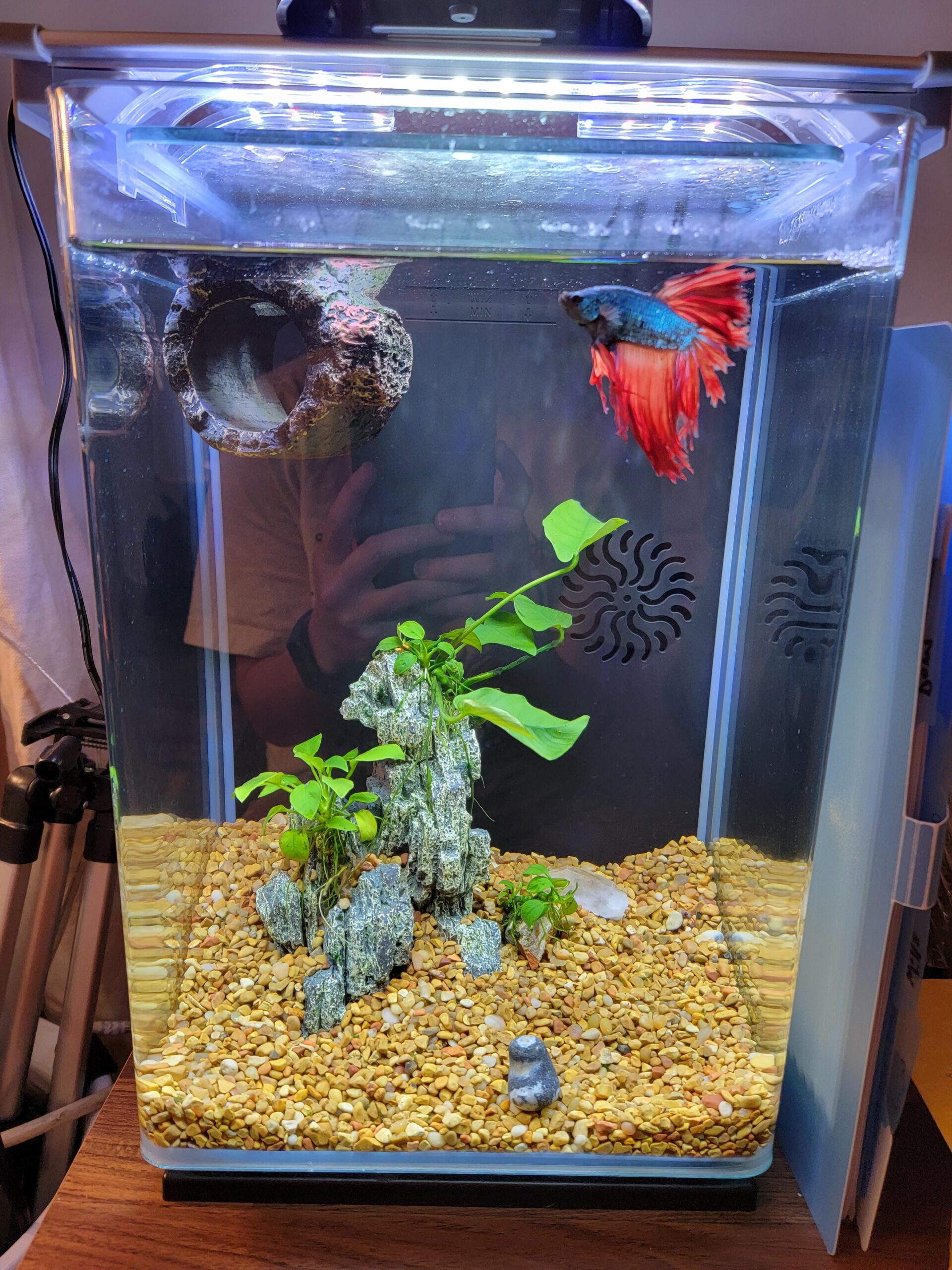
- Amazon Sword (Echinodorus amazonicus):
- Description: A large, broad-leaved plant that adds a striking focal point to a tank.
- Benefits for Bettas: Provides ample shade and cover. Helps oxygenate the water.
- Care Requirements: Moderate to high light. Needs a nutrient-rich substrate and regular fertilization.
- Potential Drawbacks: It can grow quite large, potentially overcrowding a small tank.
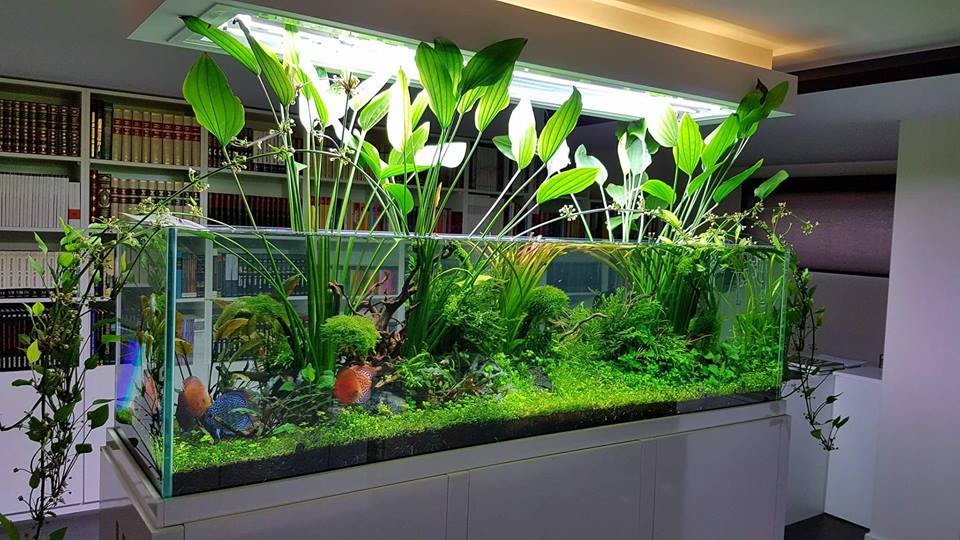
- Marimo Moss Balls (Aegagropila linnaei):
- Description: It is not moss but algae that forms into soft, green balls.
- Benefits for Bettas: Adds visual interest and can be used as a plaything for bettas to push around. Helps improve water quality.
- Care Requirements: Low light is sufficient. Requires occasional gentle squeezing to release trapped air bubbles.
- Potential Drawbacks: Slow growth.
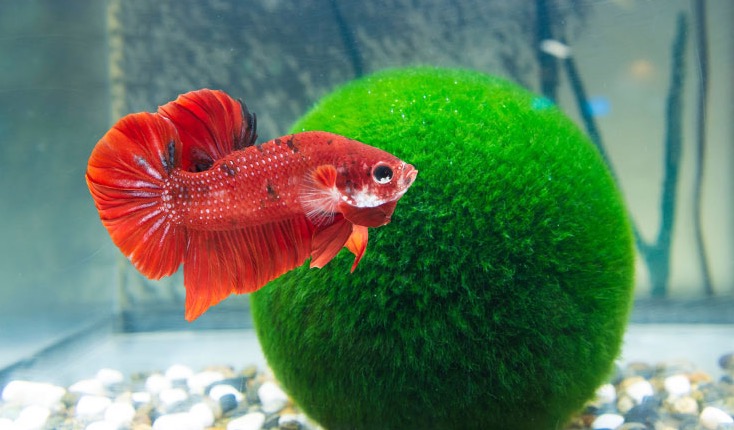
- Java Moss (Taxiphyllum barbieri):
- Description: A versatile moss attached to surfaces or left to float freely.
- Benefits for Bettas: It creates a natural, lush look. Provides cover for fry and hiding spots for adults.
- Care Requirements: Low to moderate light. It can be prone to massive algae growth if not maintained.
- Potential Drawbacks: Can proliferate and become unruly if not pruned regularly.
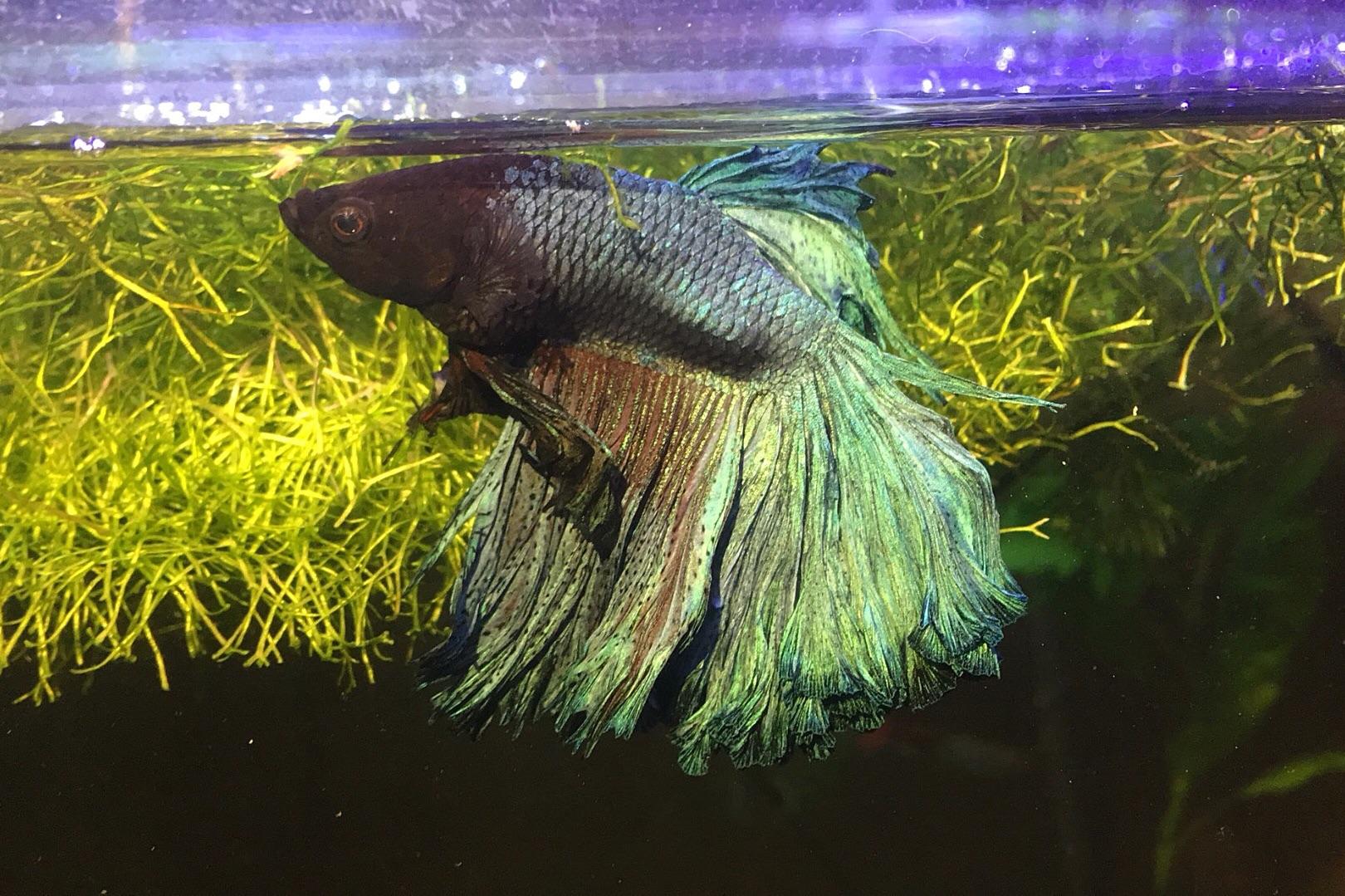
- Hornwort (Ceratophyllum demersum):
- Description: A fast-growing stem plant that can be planted or left to float.
- Benefits for Bettas: They provide excellent cover and help oxygenate the water. Absorbs excess nutrients, aiding in water quality.
- Care Requirements: Moderate to high light. It can be prone to algae growth if lighting is too intense.
- Potential Drawbacks: Fast growth can require frequent trimming.

- Cryptocoryne (Cryptocoryne wendtii):
- Description: A diverse group of plants with varying leaf shapes and colors.
- Benefits for Bettas: Creates a visually appealing environment. Offers hiding spots and shade.
- Care Requirements: Low to moderate light. It can be sensitive to sudden changes in water parameters, sometimes experiencing “Cryptocoryne melt” when first introduced to a tank.
- Potential Drawbacks: Can be slow to establish.

- Water Wisteria (Hygrophila difformis):
- Description: A fast-growing stem plant with delicate, feathery leaves.
- Benefits for Bettas: Provides cover and helps oxygenate the water. Absorbs excess nutrients.
- Care Requirements: Moderate to high light. Needs regular pruning to maintain shape.
- Potential Drawbacks: Fast growth can lead to overcrowding.
![]()
- Vallisneria (Vallisneria spiralis):
- Description: A tall, grass-like plant that adds a vertical dimension to a tank.
- Benefits for Bettas: Creates visual barriers and hiding spots. Helps oxygenate the water.
- Care Requirements: Moderate to high light. It can grow quite tall, requiring a taller tank or regular trimming.
- Potential Drawbacks: Can grow quickly and become invasive if not managed.
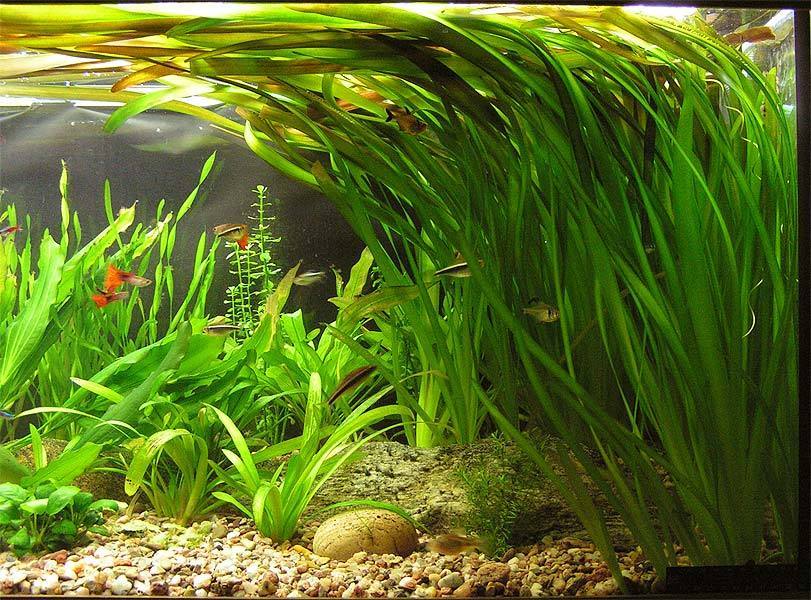
- Floating Plants (Duckweed, Frogbit):
- Description: Small plants that float on the water’s surface.
- Benefits for Bettas: Provide shade and cover, particularly for bettas who prefer to stay near the surface. Help reduce algae growth by limiting light penetration.
- Care Requirements: Moderate light. Can multiply quickly and need to be thinned out regularly to prevent overcrowding.
- Potential Drawbacks: Can block light from reaching submerged plants.
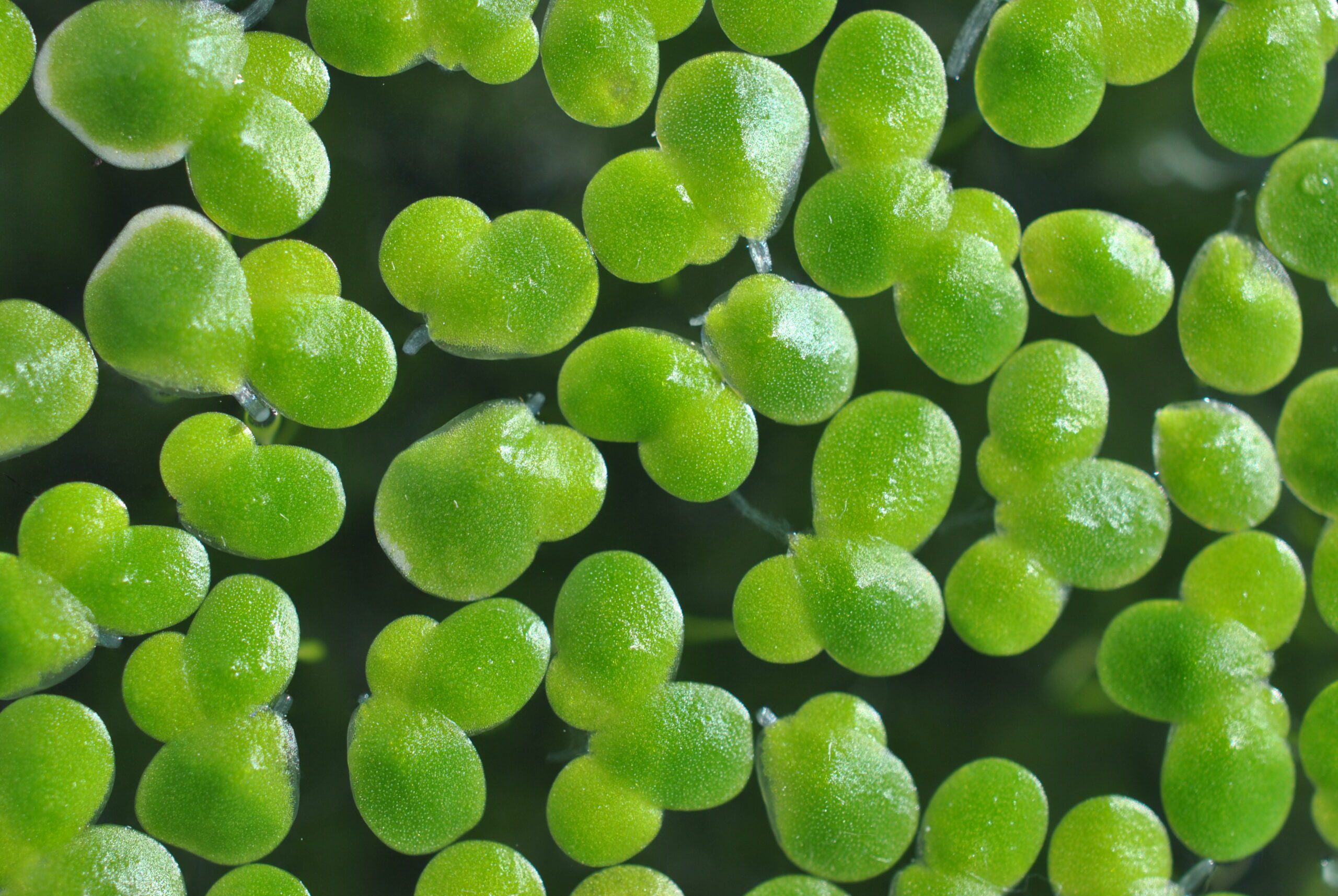
Tips for Maintaining a Healthy Planted Betta Tank
- Lighting Requirements: Different plants have varying light needs. It’s essential to balance your plants’ lighting requirements with your betta’s needs. Most plants will thrive with 8-10 hours of light per day. It’s important to maintain a consistent light cycle for healthy plant growth.
- Water Parameters: Optimal water conditions are pH between 6.5 and 7.5, moderate water hardness, and a temperature between 78-82°F. Regular water changes are essential to replenish nutrients and remove waste products.
- Regular Maintenance: Prune your plants regularly to maintain their shape and prevent overcrowding. Remove any dead or decaying leaves promptly. Clean the substrate and filter regularly to avoid the buildup of debris and harmful substances.
- Troubleshooting Common Issues: Algae blooms, nutrient deficiencies, and plant diseases can sometimes occur in planted tanks. Many resources are available online and at your local fish store to help you troubleshoot common issues.
Benefits of Live Plants in a Betta Tank
- Natural Habitat Simulation: Betta fish originate from Southeast Asia’s shallow, slow-moving waters, surrounded by dense vegetation. Live plants in your aquarium mimic this natural environment, providing visual barriers, hiding places, and a sense of security. Live plants reduce stress and can encourage natural behaviors such as exploring, foraging, and resting.
- Water Quality Improvement: Live plants play an active role in maintaining water quality. They absorb nitrates and other harmful substances, produce oxygen, and help stabilize water conditions. Plants also compete with algae for nutrients, helping control algae growth.
- Aesthetic Appeal: A well-planted betta tank is a living piece of art. Live plants’ vibrant colors and textures create a visually stunning underwater landscape that is both captivating and calming. A beautiful aquarium is enjoyable for both the fish and the owner.
- Enrichment and Stimulation: Live plants provide betta fish with opportunities for exploration and interaction. They offer places to hide, rest, and even play. The gentle movement of plants in the water current can also be visually stimulating for your fish. Additionally, live plants can stimulate natural foraging behavior, as bettas may pick at the plants looking for tasty morsels.
Mason Jar Aquaponics
In an age where sustainable living and DIY projects are more popular than ever, aquaponics stands out as a fascinating way to grow your own food in a small space. Combining the best of aquaculture and hydroponics, aquaponics is an efficient system where fish (did you know that bettas are great for this?) and plants work together in a symbiotic relationship. But what if you don’t have the space or resources for a large aquaponics setup? Enter the mason jar aquaponics system—a compact, cost-effective, and educational way to bring the benefits of aquaponics into your home.
What is Aquaponics?
Click here for a more robust Aquaponics system
Aquaponics is a method of farming & growing your own food that combines aquaculture (raising fish) with hydroponics (growing plants without soil). In an aquaponics system, fish waste provides nutrients for plants; in return, the plants help filter and clean the water for the fish. This creates a closed-loop system that mimics natural ecosystems, resulting in a highly efficient and sustainable way to grow food.
Benefits of Aquaponics include:
- Sustainability: Uses 90% less water than traditional farming.
- Efficiency: Produces food faster and with fewer resources.
- Low Maintenance: Once established, aquaponics systems require minimal upkeep.
Why Choose Mason Jar Aquaponics?
Mason jar aquaponics is perfect for those looking to start small. Here’s why:
- Portability: Mason jars are compact and easy to move, making them ideal for small living spaces.
- Cost-Effectiveness: A mason jar setup is much cheaper than larger systems, with most materials readily available at home or from local stores.
- Accessibility: It’s a great beginner project that introduces the basics of aquaponics without the need for a large investment.
Materials Needed
Before you begin, gather the following materials:
- Mason Jar: A quart-sized jar works well, but you can choose whatever size that suits you.
- Small Fish: Betta fish, goldfish, or guppies are good choices for a mason jar environment.
- Aquatic Plants: Easy-to-grow plants like basil, lettuce, or mint.
- Aquaponic Media: Pebbles or clay balls for the base layer.
- Additional Supplies: A small air pump (optional but recommended), fish food, and a light source (a sunny window or LED grow light).
Step-by-Step Guide to Setting Up Mason Jar Aquaponics
Step 1: Preparing the Mason Jar Start by thoroughly cleaning the mason jar with warm water and soap. Rinse well and make sure you get all the soap out.
Step 2: Setting Up the Base Layer Add a layer of aquaponic media to the bottom of the jar. This will help anchor the plants and provide surface area for beneficial bacteria to grow.
Step 3: Adding the Aquatic Plants Select a small plant or several seedlings and gently place them into the jar. Ensure the roots are well supported by the media and leave enough room for the fish to swim comfortably.
Step 4: Introducing the Fish Before adding your fish, make sure the water is treated and at the appropriate temperature. Place the fish in a separate container with the jar of water to acclimate them before transferring them to the jar.
Step 5: Maintaining the System. Feed the fish daily and monitor the water quality. The plants should begin to thrive as they absorb nutrients from the fish waste, and the fish will benefit from the cleaner water the plants provide.
Maintenance and Troubleshooting
Regular Care
- Feed the fish daily, but avoid overfeeding to prevent water contamination.
- Top off the water as needed, especially in warmer weather.
- Check the health of both the fish and plants regularly.
Common Issues
- Algae Growth: If algae begin to form, reduce the amount of light exposure or clean the jar.
- Plant Wilting: Ensure the plant roots are properly anchored and that the water quality is sufficient.
- Fish Health: If the fish seem sluggish or sick, check the water temperature, cleanliness, and oxygen levels.
Long-Term SustainabilityWith proper care, your mason jar aquaponics system can thrive for months, providing a continual source of fresh herbs or greens and a healthy environment for your fish.
Educational and Practical Applications
Learning Tool Mason jar aquaponics makes an excellent educational project for both kids and adults. It teaches the basics of biology, ecology, and sustainable practices in a hands-on way.
Home Décor These mini ecosystems can also serve as a unique and functional piece of home or office décor. Place them on a windowsill or desk for a touch of green and a conversation starter.
Small-Scale Food Production While you won’t be harvesting enough to feed a family, growing herbs like basil or mint in your mason jar system can provide fresh ingredients for your kitchen.
Conclusion
Mason jar aquaponics is a fun, affordable, and educational way to explore the world of aquaponics on a small scale. Whether you’re looking to grow fresh herbs, learn about ecosystems, or simply add a touch of green to your space, this DIY project is an excellent place to start. So, gather your materials, follow the steps, and enjoy watching your miniature aquaponics system thrive.
Betta Fish Mating Information
Ever watched two betta fish dance around each other, flashing their vibrant colors? That’s not just a show – it’s the beautiful ballet of betta fish courtship! If you’ve ever been captivated by these mesmerizing creatures, you might have wondered about their mating rituals and how to breed them responsibly. In this guide, we’ll uncover the secrets of their underwater love story, from the natural behaviors of wild bettas to the step-by-step process of breeding them in your aquarium. Whether you’re a curious betta enthusiast or an aspiring breeder, this guide is for you!
Betta Fish in the Wild: A Match Made in Nature
Imagine Southeast Asia’s lush, tropical waters, where betta fish originate. Male bettas construct elaborate bubble nests to attract mates amidst vibrant plants and crystal-clear streams. These saliva bubbles nests are both a romantic gesture and a safe haven for future betta babies.
But building a nest is just the beginning! Male bettas also perform elaborate courtship dances, flaring their fins and showcasing their vibrant colors to impress potential partners. Meanwhile, female bettas carefully assess these displays, choosing the most impressive suitor to father their offspring.
Fun Fact: Did you know male bettas build bubble nests to protect their eggs and young? It’s like a floating nursery!
Ready, Set, Breed! Preparing for Betta Fish Romance
If you’re ready to embark on the betta breeding journey, the first step is to select healthy, compatible breeding pairs.
Tip: Look for active, vibrant fish with good finnage and no signs of disease.
Next, you must create a comfortable breeding environment for your bettas. This means setting up a suitable tank with the right conditions and equipment.
Checklist:
- 5-10 gallon tank
- Heater to maintain water temperature between 78-82°F
- Sponge filter for gentle water circulation
- Hiding places for the female (e.g., plants, caves)
- Lid to prevent jumping and maintain humidity
Tip: A spawning site like a floating leaf or breeding mop can encourage egg-laying.
Pro Tip: Conditioning your bettas with a nutritious diet of live or frozen foods, such as brine shrimp or bloodworms, is key to successful breeding!
How To Select a Breeding Pair
Choosing the right breeding pair of betta fish can make all the difference in ensuring a smooth and healthy spawning experience. Here’s a simple guide on what to look for and how to prepare your fish for successful breeding.
Health and Condition
Healthy fish are essential for producing strong offspring. When picking a pair:
- Look for clear, bright eyes and vibrant colors.
- Check that fins are intact and show no signs of damage.
- Avoid fish that seem lethargic or have dull colors, indicating poor health.
- Avoid any signs of illness, like fin rot or discoloration, which may impact their ability to breed.
Behavior and Temperament
Betta fish can be territorial, so selecting fish with compatible temperaments is crucial. Keep these tips in mind:
- Observe each fish’s behavior; look for calm individuals rather than overly aggressive ones.
- Watch for breeding readiness in the male, such as building a bubble nest and becoming more territorial.
- Look for vertical breeding stripes on the female and a rounder belly, both signs she’s ready to spawn.
- Be prepared to separate them if aggression escalates—compatibility isn’t always guaranteed.
Physical Compatibility
Physical traits play an important role in successful breeding. Here’s what to check:
- Choose a male with a large, full tail, which helps the breeding embrace.
- Ensure the female has a rounded belly, which usually indicates she’s carrying eggs.
- Select fish that are similar in size for smoother interaction and compatibility.
Conditioning for Breeding
Conditioning your fish before breeding is essential. This helps with both their reproductive health and adjustment to each other’s presence:
- Start by feeding both fish a high-protein diet for about one to two weeks.
- Let the pair get used to each other by placing their tanks close together.
- Prepare a breeding tank with shallow water (6–8 inches), floating plants for nest-building, and hiding spots for the female.
- Ensure the water parameters—such as temperature and pH—are optimal to encourage natural spawning behaviors.
The Betta Fish Tango: From Courtship to Eggs
So, how can you tell when your bettas are ready to mate? Look for these telltale signs:
Signs:
- Male builds a bubble nest
- Female develops vertical stripes (breeding bars)
- Both fish display vibrant colors and flaring fins
Once you’ve observed these signs, you can carefully introduce the pair.
Tip: Introduce them gradually through a divider to gauge their reactions before allowing them to interact directly.
If all goes well, you’ll witness the captivating spawning embrace, where the male wraps his body around the female, fertilizing her eggs as she releases them. Afterward, the male will diligently collect the eggs and place them in his bubble nest, caring for them until they hatch.
Reminder: Gently remove the female after spawning to prevent any conflicts.
Tiny Fins and Big Appetites: Raising Betta Fry
Congratulations! If the mating was successful, you’ll soon see tiny betta fry emerging from the eggs.
As the fry grow, they’ll need a nutritious diet to thrive.
Tip: Start with infusoria (microscopic organisms) and gradually introduce baby brine shrimp as the fry grow.
It’s fascinating to watch these tiny creatures develop and grow. To prevent fighting, remember to separate the males at around 2-3 months old when their fins start to develop.
Did You Know? Baby betta fish are called fry! They’re so tiny and cute!
Troubleshooting Betta Fish Breeding: Overcoming Challenges
While betta fish breeding can be rewarding, it’s not always smooth sailing. You might encounter challenges like aggression between the pair, egg fungus, or fry mortality.
But don’t worry, there are solutions!
Tip: If aggression persists, separate the pair and try again later.
Tip: Add a few Indian Almond leaves to the tank to help prevent fungus growth.
Tip: Maintain clean water conditions and provide frequent, small feedings to ensure healthy fry.
Responsible Breeding: More Than Just Cute Babies
Breeding betta fish is a responsibility, not just a hobby. It’s essential to prioritize the well-being of the fish and avoid contributing to pet overpopulation.
Before you start breeding, research betta fish genetics and understand the potential risks of certain breeding practices. Always find loving homes for any offspring you cannot keep. Remember, ethical breeding is about preserving the health and beauty of these amazing creatures.


